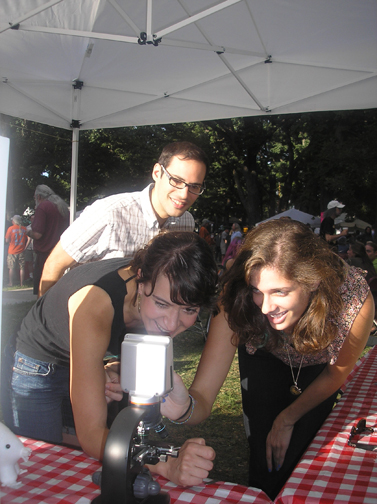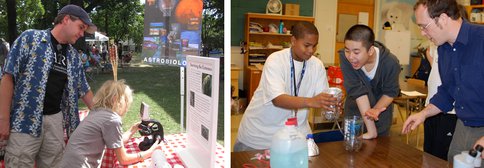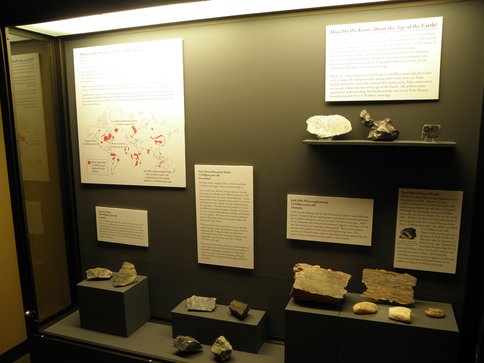2011 Annual Science Report
 University of Wisconsin
Reporting | SEP 2010 – AUG 2011
University of Wisconsin
Reporting | SEP 2010 – AUG 2011
EPO Activity: Education and Public Outreach Activities at the University of Wisconsin
Project Progress
EPO: Imagine Mars at Toki Middle School
The Imagine Mars program at Akira Toki Middle School in Madison, Wisconsin took the form of an after school science club in which a group of 8-12 students met for one hour per week over the course of six weeks. The program was conducted by University of Wisconsin postdoc Ken Williford and undergraduate biology major Tom Bryan, and was designed to inspire students about science by involving them in the design and construction of bottle-based growing systems of increasing complexity, all in the context of astrobiology and an imagined human settlement on Mars. In each of the first four sessions, students built their own closed growing systems and discussed relevant topics about the basic requirements for life on Earth and other planets. In the final two sessions, students cooperatively designed and built a larger, hydroponic growing system and discussed how this related to the requirements for interplanetary human space exploration and terraforming.
EPO: Astrobiology at Local Music Festivals
Over the course of the Summer of 2011, WARC personnel set up a tent at three local music festivals in Madison, Wisconsin. The Wisconsin Astrobiology Research Consortium partnered with the Marquette Neighborhood Association and the Wil-Mar Neighborhood Center (both in Madison, Wisconsin) to bring astrobiology outreach to three summer music festivals. Our outreach activities at the festivals centered around a booth outfitted to look like a backyard patio where members of the public could come in and learn about “Astrobiology in Your Backyard”. We used tardigrades, micro-meteorites, lichens, and stromatolite fossils as launching-off points to engage the public in learning about astrobiology research.
Figure 1. Left photo: Post-doc Andy Czaja staffs the “Astrobiology in Your Backyard” booth at a Madison, WI music festival in Summer 2011. Right photo: Post-doc Ken Williford looks on as Akira Toki middle school students operate the hydroponic system they built during the Imagine Mars after school science club.

Figure 2. Music festvial attendees had a chance to look at magnified tardigrades to learn about the extremes life can endure.
Evaluation forms about participants experiences interacting with WARC personnel and learning about astrobiology indicate we were successful in engaging our audience. Responses follow:
“This event has helped me learn new things about the search for life in space.”
91 percent responded “agree” or “strongly agree”
“This event has made me want to learn more about the search for life in space.”
80 percent responded “agree” or “strongly agree”
“This event has increased my interest in science.”
80 percent responded “agree” or “strongly agree”
EPO: Life in the Extreme Trading Cards
Developed over the last two years, this educational product has nine trading cards, each of which features a different extremophile group. The front of each card has an image of an environment in which the extremophiles thrive (e.g. Grand Prismatic Spring at Yellowstone for the thermophiles). The back of each card has a small photo of a representational organism (e.g. Deinococcus radiodurans for the radioresistant microbes) and engaging text about each group’s “Extreme Abilities”, “Extreme Environments” and “Extreme Examples”. Packs of these cards are now available and are being distributed nationwide.
Figure 3. A PDF of the “Life in the Extremes” Trading Cards
While the trading cards have been used at many events, evaluation conducted at the Astrobiology at Local Music Festivals included a specific question about this educational product. Of those who filled out evaluation forms 82 percent responded “agree” or “strongly agree” to a question asking about whether they found the trading cards informative.
EPO: Biosignatures Museum Exhibit
In November, 2010 the UW Geology Museum installed the first phase of a 250 square foot permanent exhibit on early Earth and how NASA-funded research pertains to the search for life elsewhere in the Solar System and beyond. The exhibit highlights Earth’s oldest rocks and fossils, emphasizing that these are our windows into understanding the beginning of life on our own planet. Specimens include: Acasta gneiss from Canada (4.03 Ga), metasediments from the Isua supracrustal belt in Greenland (3.8 Ga), a large chunk of conglomerate from the Jack Hills in Australia (3.0 Ga), Australian Tiger Iron (2.5 Ga), a stromatolite from the Trendall locality in Australia (3.35 Ga), Grypania (1.85 Ga), Gunflint chert microfossils (1.8 Ga), Copper Harbor Stromatolite (1.1 Ga), Burgess Shale Lagerstatte (505 Ma) and Waukesha Lagerstatte (430 Ma).
Figure 4. A case in the biosignatures exhibit uses Earth’s oldest rocks to address early Earth environments.
Figure 5. A case in the biosignatures exhibit features the oldest evidence of life on Earth.
EPO: Public lectures and interviews by UW-Madison and George Washington team members
Nita Sahai was interviewed, in November 2011, on National Public Radio’s program “To the Best of Our Knoweldge” where she explained the current understanding of how pre-biotic molecules may have helped in the self-assembly of organic molecules and the transition to the earliest forms of life (http://ttbook.org/book/nita-sahai).
Clark Johnson gave a two hour public lecture on “Search for Life on Mars” in March, 2011 at the University of Wisconsin Space Place. Space Place is the education and public outreach center of the UW-Madison Astronomy Department.
Pascale Ehrenfreund gave a press briefing and two public lectures:
O/OREOs Launch Campaign, Press and public briefing, November 19, 2010,
NASA Ames Research Center
Vrije University Amsterdam, November 30, 2010, Amsterdam, NL
“First Life on Earth and Life elsewhere”
International Space University ISU Summerschool, July 2011, Graz, Austria
Core Lecturer: “Astrobiology: the search for life in the universe”



